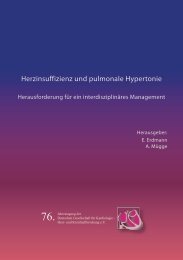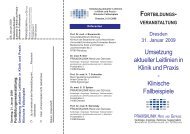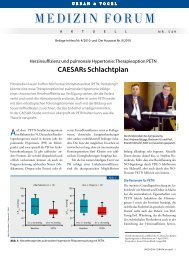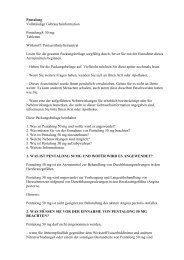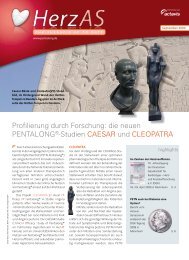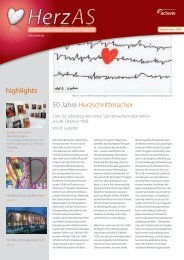HerzSupplement - Pentalong von Actavis
HerzSupplement - Pentalong von Actavis
HerzSupplement - Pentalong von Actavis
Erfolgreiche ePaper selbst erstellen
Machen Sie aus Ihren PDF Publikationen ein blätterbares Flipbook mit unserer einzigartigen Google optimierten e-Paper Software.
we speculate that GTN affects ROS formation<br />
more than other nitrates due to its<br />
strong inhibitory effect on ALDH2dehydrogenase<br />
activity.<br />
Keywords: organic nitrates – reactive oxygen<br />
species – dihydrorhodamine 123 –<br />
mitochondrial aldehyde dehydrogenase<br />
Literatur<br />
1. Munzel T et al. Evidence for enhanced vascular superoxide<br />
anion production in nitrate tolerance. A novel<br />
mechanism underlying tolerance and cross-tolerance.<br />
J Clin Invest 1995;95(1): 187–94<br />
2. Daiber A et al. The oxidative stress concept of nitrate<br />
tolerance and the antioxidant properties of hydralazine.<br />
Am J Cardiol 2005;96(7B):25i–36i<br />
3. Daiber A et al. Nitrate tolerance as a model of vascular<br />
dysfunction: roles for mitochondrial aldehyde dehydrogenase<br />
and mitochondrial oxidative stress. Pharmacol<br />
Rep 2009;61(1):33–48<br />
4. Daiber A et al. New insights into bioactivation of organic<br />
nitrates, nitrate tolerance and cross-tolerance.<br />
Clin Res Cardiol 2008;97(1):12–20<br />
5. Wenzel P et al. Role of reduced lipoic acid in the redox<br />
regulation of mitochondrial aldehyde dehydrogenase<br />
(ALDH-2) activity. Implications for mitochondrial oxidative<br />
stress and nitrate tolerance. J Biol Chem<br />
2007;282(1):792–9<br />
6. Ischiropoulos, H et al. Detection of reactive nitrogen<br />
species using 2,7-dichlorodihydrofluorescein and<br />
dihydrorhodamine 123. Methods Enzymol 1999;301:<br />
367–73<br />
7. Johnson LV, Walsh ML, Chen LB. Localization of mitochondria<br />
in living cells with rhodamine 123. Proc Natl<br />
Acad Sci U S A 1980;77(2):990–4<br />
8. Sydow K et al. Central role of mitochondrial aldehyde<br />
dehydrogenase and reactive oxygen species in nitroglycerin<br />
tolerance and cross-tolerance. J Clin Invest<br />
2004;113(3):482–9<br />
9. Schwemmer M, Bassenge E. New approaches to overcome<br />
tolerance to nitrates. Cardiovasc Drugs Ther<br />
2003;17(2):159–73<br />
10. Dikalov S et al. Formation of reactive oxygen species<br />
by pentaerithrityltetranitrate and glyceryl trinitrate<br />
in vitro and development of nitrate tolerance. J Pharmacol<br />
Exp Ther 1998;286(2):938–44<br />
11. Daiber A et al. Oxidative stress and mitochondrial<br />
aldehyde dehydrogenase activity: a comparison of<br />
pentaerythritol tetranitrate with other organic nitrates.<br />
Mol Pharmacol 2004;66(6):1372–82<br />
12. Schulz E et al. Functional and biochemical analysis of<br />
endothelial (dys)function and NO/cGMP signaling in<br />
human blood vessels with and without nitroglycerin<br />
pretreatment. Circulation 2002;105(10):1170–5<br />
13. Rosenkranz AC et al. Endothelial antioxidant actions of<br />
dihydropyridines and angiotensin converting enzyme<br />
inhibitors. Eur J Pharmacol 2006;529(1–3):55–62<br />
14. Lob H et al. Antioxidant and nitric oxide-sparing actions<br />
of dihydropyridines and ACE inhibitors differ in<br />
human endothelial cells. Pharmacology 2006;76(1):<br />
8–18<br />
Herz 35 · 2010 · Supplement II © Urban & Vogel<br />
15. Donnenberg VS, Meyer EM, Donnenberg AD. Measurement<br />
of multiple drug resistance transporter activity<br />
in putative cancer stem/progenitor cells. Methods<br />
Mol Biol 2009;568:261–79<br />
16. Nare B, Prichard RK. Georges E. Characterization of<br />
rhodamine 123 binding to P-glycoprotein in human<br />
multidrug-resistant cells. Mol Pharmacol 1994;45(6):<br />
1145–52<br />
17. Qadir M et al. Cyclosporin A is a broad-spectrum multidrug<br />
resistance modulator. Clin Cancer Res<br />
2005;11(6):2320–6<br />
18. Gori T et al. The mechanism of nitrate-induced preconditioning.<br />
Clin Hemorheol Microcirc 2008;39(1–4):<br />
191–6<br />
19. Gori T, Parker JD. Nitrate-induced toxicity and preconditioning:<br />
a rationale for reconsidering the use of<br />
these drugs. J Am Coll Cardiol 2008;52(4):251–4<br />
20. Bernardi P et al. The mitochondrial permeability transition<br />
from in vitro artifact to disease target. Febs J<br />
2006;273(10):2077–99<br />
21. Abou-Mohamed G et al. Roles of superoxide, peroxynitrite,<br />
and protein kinase C in the development<br />
of tolerance to nitroglycerin. J Pharmacol Exp Ther<br />
2004;308(1):289–99<br />
22. Munzel T, Harrison DG. Evidence for a role of oxygenderived<br />
free radicals and protein kinase C in nitrate<br />
tolerance. J Mol Med 1997;75(11–12):891–900<br />
23. Munzel T et al. Hydralazine prevents nitroglycerin<br />
tolerance by inhibiting activation of a membranebound<br />
NADH oxidase. A new action for an old drug. J<br />
Clin Invest 1996;98(6):1465–70<br />
24. Daiber A et al. Heterozygous deficiency of manganese<br />
superoxide dismutase in mice (Mn-SOD+/-): a novel<br />
approach to assess the role of oxidative stress for the<br />
development of nitrate tolerance. Mol Pharmacol<br />
2005;68(3):579–88<br />
25. Banks D, Soliman MR. Protective effects of antioxidants<br />
against benomyl-induced lipid peroxidation<br />
and glutathione depletion in rats. Toxicology<br />
1997;116(1–3):177–81<br />
26. Leiphon LJ, Picklo MR. Inhibition of aldehyde detoxification<br />
in CNS mitochondria by fungicides. Neurotoxicology<br />
2007;28(1):43–9<br />
27. Jurt U et al. Differential effects of pentaerythritol tetranitrate<br />
and nitroglycerin on the development of<br />
tolerance and evidence of lipid peroxidation: a human<br />
in vivo study. J Am Coll Cardiol 2001;38(3):854–9<br />
Für die Verfasser:<br />
Dr. Tim Bauer<br />
Uniklinik Köln, Institut für Pharmakologie<br />
Gleueler Straße 24<br />
50931 Köln, Germany<br />
Tel.: +49 (0) 221 4786038<br />
Fax: +49 (0) 221 4785022<br />
E-Mail: tim.bauer@uk-koeln.de<br />
Organische Nitrate<br />
55




